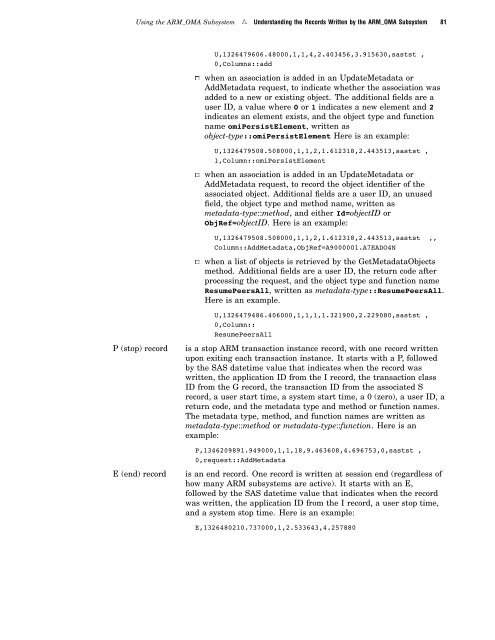SAS 9.1.3 Intelligence Platform: System Administration Guide
SAS 9.1.3 Intelligence Platform: System Administration Guide
SAS 9.1.3 Intelligence Platform: System Administration Guide
Create successful ePaper yourself
Turn your PDF publications into a flip-book with our unique Google optimized e-Paper software.
Using the ARM_OMA Subsystem R Understanding the Records Written by the ARM_OMA Subsystem 81<br />
U,1326479606.48000,1,1,4,2.403456,3.915630,sastst ,<br />
0,Columns::add<br />
3 when an association is added in an UpdateMetadata or<br />
AddMetadata request, to indicate whether the association was<br />
added to a new or existing object. The additional fields are a<br />
user ID, a value where 0 or 1 indicates a new element and 2<br />
indicates an element exists, and the object type and function<br />
name omiPersistElement, written as<br />
object-type::omiPersistElement Here is an example:<br />
U,1326479508.508000,1,1,2,1.612318,2.443513,sastst ,<br />
1,Column::omiPersistElement<br />
3 when an association is added in an UpdateMetadata or<br />
AddMetadata request, to record the object identifier of the<br />
associated object. Additional fields are a user ID, an unused<br />
field, the object type and method name, written as<br />
metadata-type::method, and either Id=objectID or<br />
ObjRef=objectID. Here is an example:<br />
U,1326479508.508000,1,1,2,1.612318,2.443513,sastst ,,<br />
Column::AddMetadata,ObjRef=A9000001.A7EADO4N<br />
3 when a list of objects is retrieved by the GetMetadataObjects<br />
method. Additional fields are a user ID, the return code after<br />
processing the request, and the object type and function name<br />
ResumePeersAll, written as metadata-type::ResumePeersAll.<br />
Here is an example.<br />
U,1326479486.406000,1,1,1,1.321900,2.229080,sastst ,<br />
0,Column::<br />
ResumePeersAll<br />
P (stop) record is a stop ARM transaction instance record, with one record written<br />
upon exiting each transaction instance. It starts with a P, followed<br />
by the <strong>SAS</strong> datetime value that indicates when the record was<br />
written, the application ID from the I record, the transaction class<br />
ID from the G record, the transaction ID from the associated S<br />
record, a user start time, a system start time, a 0 (zero), a user ID, a<br />
return code, and the metadata type and method or function names.<br />
The metadata type, method, and function names are written as<br />
metadata-type::method or metadata-type::function. Here is an<br />
example:<br />
P,1346209891.949000,1,1,18,9.463608,4.696753,0,sastst ,<br />
0,request::AddMetadata<br />
E (end) record is an end record. One record is written at session end (regardless of<br />
how many ARM subsystems are active). It starts with an E,<br />
followed by the <strong>SAS</strong> datetime value that indicates when the record<br />
was written, the application ID from the I record, a user stop time,<br />
and a system stop time. Here is an example:<br />
E,1326480210.737000,1,2.533643,4.257880
















